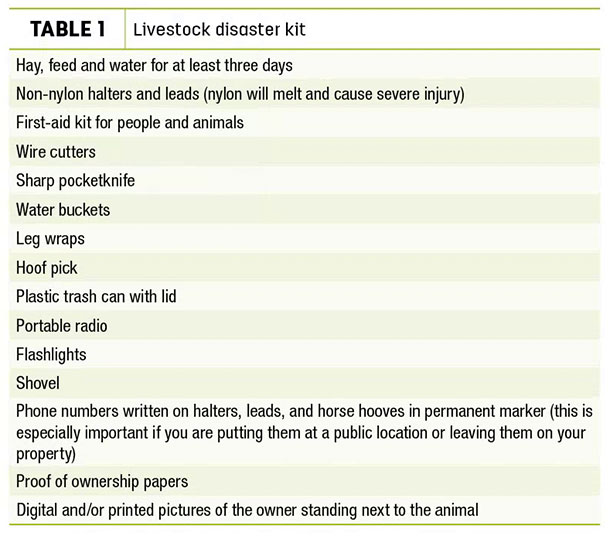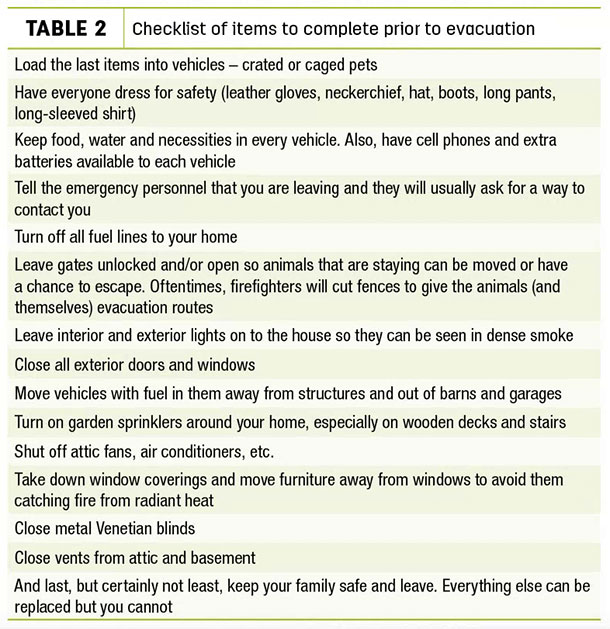As the year progresses, the fire season will extend into the western and northwestern states, and north into the Midwest.
The recent fire in the Texas Panhandle is estimated to have caused an agricultural loss of $21 million. With losses that high, and insurance and government programs only able to recuperate a portion of that cost, a fire could put a cattle producer out of business.
With 90 percent of wildfires being caused by humans and only 10 percent to lightning or lava, cattlemen need to be prepared for the unpredictability of a wildfire before it is a threat to their own property. This includes maintaining defensible space, preparedness strategies, kits for humans and livestock, evacuation order preplanning and evacuation tasks to complete.
Defensible space
Valuable resources exist to prepare yourself and property prior to the event of a wildfire. One of the best strategies is having defensible space around your house and structures. By removing flammable vegetation, using fire breaks and strategic grazing, landowners can reduce the potential risks and provide fire crews a possible space to stop the oncoming fire as it approaches homes.
Defensible space is a perimeter around your home, barns and outbuildings that has been cleared of excess fuel. Different states have different laws regarding how large the perimeter needs to be, but most recommendations advise a 30-foot immediate perimeter around buildings known as zone 1 and a larger perimeter from 30 to 100 feet known as zone 2.
In these spaces, all dead trees, grass and shrubs should be removed, and grass should be kept green and cut short. Tree branches should be trimmed with limbs no lower than 6 feet from the ground.
There should also be no propane tanks, firewood or other fuels in zone 1 perimeter and consider using fire-resistant materials for decks, outdoor furniture, play equipment, etc.
Removing “vertical fire ladders” is also recommended. This is when smaller bushes or trees come in contact with larger ones, creating a way for fire to move upward into the tree canopy. Also, cut tall trees to make sure the canopies of each tree do not touch. If keeping these zones watered and green is an issue, consider using xeriscaping techniques.
Have a livestock disaster preparedness kit ready
Prior to fire season, having a disaster kit ready for any emergency is a good idea. Table 1 shows a list of suggested items to have ready and in a convenient location, such as a stock trailer. This list can always be expanded to include items for different emergency situations.

Before the evacuation order comes, you should already have large livestock and horses loaded into trailers or already moved to a safe location. Have pets crated and ready to load into vehicles or already relocated.
Animals that cannot be relocated need to be moved to a defensible space on your property. This would be an already-grazed pasture with little fuel. Make sure they have full water tanks, and do not rely on automatic water systems.
Have numerous evacuation routes planned out and a contact person or location for everyone to meet that is safe. Have a time set – that if someone does not arrive or check in by the predetermined time, then they are considered in need of help or are in danger and call emergency personnel for assistance in locating them.
Have a location that everyone is familiar with, but is a safe distance away. This could be a friend or family member, a veterinarian’s office, the county fairgrounds or rodeo arena.
The local fire departments, law enforcement, veterinarians, animal rescue groups and county extension offices receive phone calls from people offering resources to evacuees and their animals. Please call them if you need additional help. There is often offers of manpower, trucks and trailers, feed and housing.
Table 2 shows a checklist of items to complete as you are readying to leave the evacuated area. Because of the unpredictability of fire, having a portion or most of the checklist complete prior to a formal evacuation order is a good idea.

According to Idaho Frewise, Inc., which is a very valuable resource to find this information and plenty more on this subject, “Do not wait to be told to evacuate. Sixty percent of lives lost to wildland fire are of those that chose to stay and wait and see, and then evacuated too late.”
Where to find more resources
For more information on your insurance policies, contact your agent. They may also have resources available for fire prevention. The National Interagency Fire Agency publishes a weekly and daily fire report that is available at National Interagency Fire Center. The National Weather Service, shows weather patterns that could increase fire dangers. “Ready, Set, Go! Wildfire Preparedness for Farmers, Ranchers and Growers,” is a more comprehensive planning guide that is available for free online.
Our sincerest condolences are with the families that have lost loved ones while in pursuit to save their animals and land during the wildfires of 2017. ![]()
References omitted but are available upon request. Click here to email an editor.

-
Tyanne Rolandk
- Extension Educator
- University of Idaho
- Email Tyanne Roland








